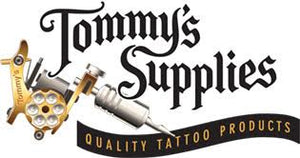Ink Expiry & Inventory Tips: What to Keep, Toss or Replace

TL;DR
Tattoo ink expires, and using expired or compromised pigment can lead to inconsistent color, poor healing, or safety risks. Artists should routinely check batch numbers, expiration dates, bottle condition, and pigment stability. Keep inks that are within date and properly stored, toss expired or separated inks, and replace essential colors before they run out. Proper inventory management ensures consistent quality and safer tattooing.
Introduction
Tattoo ink is one of the most important materials in any studio — and also one of the easiest to mismanage. Bottles get pushed to the back of shelves, dates get overlooked, and older pigments get mixed in with new inventory. The result is wasted ink, inconsistent color performance, or even client safety concerns.
A structured approach to ink management helps artists maintain professional standards, control costs, and ensure they’re always using safe, reliable pigments. This guide outlines exactly what inks to keep, what to toss, and what to replace to keep your inventory fresh and compliant.
Understanding Tattoo Ink Expiration
Every professional tattoo ink includes an expiration date and batch number. This ensures:
- The pigment remains stable
- The carrier solution remains safe
- Sterility is maintained
- The ink performs consistently
As inks age, they can:
- Thicken or separate permanently
- Lose vibrancy
- Develop microbial contamination
- Deliver uneven results
- Trigger irritation in sensitive clients
Using expired ink is not worth the risk.
What to Keep
You can safely keep inks that meet all of the following criteria:
1. In-Date With Clear Labeling
Bottles should show:
- Manufacturer
- Color name
- Batch/lot number
- Expiration date
- Sterilization indicator
Ink without clear labeling should not remain in your working collection.
2. Properly Stored
Ink bottles should be stored:
- Upright
- Out of direct sunlight
- In a cool, dry area
- With caps tightly sealed
Proper storage extends pigment stability.
3. Normal Appearance and Consistency
Healthy ink should:
- Remix smoothly with shaking
- Have no unusual odor
- Contain no clumps or grainy texture
- Fall within expected viscosity
If it behaves normally, it is generally safe to keep.
What to Toss
These inks should be removed from your studio immediately:
1. Expired Bottles
Regardless of appearance, expired ink should never be used.
Expiration dates exist for sterility, pigment stability, and safety.
2. Bottles Showing Permanent Separation
If shaking does not fully remix the ink, the pigment has broken down.
3. Discolored or Oxidized Inks
Color shifts indicate chemical instability or contamination.
4. Bottles With Damaged Seals or Caps
Any ink that may have been contaminated — even unintentionally — should be discarded.
5. Unlabeled or Mystery Bottles
If the label is faded, missing, or unreadable, toss it.
If you don’t know what’s in a bottle, it has no place in a professional studio.
What to Replace
There are several inks and supplies that studios should proactively replace each year:
1. High-Use Colors
These include:
- Lining black
- Grey washes
- Whites for highlights
- Popular primaries (reds, blues, yellows)
If you use them often, keep a backup bottle to avoid running out mid-session.
2. Specialty Colors You Use Seasonally
If you use certain skin tones, pastels, or niche shades only for specific clients or projects, double-check their dates and restock as needed.
3. Bottles Showing Early Signs of Thickening
Ink begins to thicken as it approaches expiration. Don’t push it — replace them before they reach the point of unreliability.
4. Inks Used for Cover-Ups or Detailed Work
These require perfect, predictable performance. Any degradation makes precise work harder.
Tips for Organizing Your Ink Inventory
A well-organized ink station saves time and reduces mistakes.
Use a First-In, First-Out Method
Place newer inks behind older ones to ensure older bottles get used first.
Group Inks by Family
Organize by:
- Color family
- Skin tones
- Blacks & washes
- Specialty inks
This helps you track duplicates and gaps.
Keep a Yearly or Quarterly Audit
Set a reminder to check expiration dates every:
- 3 months (ideal)
- 6 months (minimum)
- Yearly (absolute requirement)
Track Opened Dates
Mark the date you opened each bottle with a small piece of tape or marker.
Store Extras Separately
Backup bottles should be stored away from daily workstation splatter and heat.
Why Professional-Grade Ink Matters
Proper inventory management is useless without high-quality ink.
Only buy inks that are:
- Gamma sterilized
- Batch tested
- Labeled with full compliance information
- Stored and shipped correctly
- Sold by authorized distributors
Tommy’s Supplies distributes sterilized, professional-grade inks that meet strict safety and labeling standards, ensuring artists work with fresh, reliable pigments.
FAQ
How long does tattoo ink last before it expires?
Most inks last 2–5 years unopened. Always check the label for exact expiration.
Can I still use ink after the expiration date?
No. Expired ink is unsafe and must be discarded.
Why does ink separate?
Some separation is normal — but if it does not remix fully, the pigment is breaking down.
Should I refrigerate tattoo ink?
No. Store at room temperature in a cool, dry place.
Where should I buy replacement inks?
From trusted distributors like Tommy’s Supplies, which provides sterilized, fresh, fully compliant professional inks.
Conclusion
Managing tattoo ink properly is essential for maintaining professional standards, ensuring safety, and producing consistent, high-quality work. By keeping fresh inks, discarding expired or compromised bottles, and restocking essentials early, artists protect their craft and their clients.
For sterilized, batch-tested tattoo inks and professional studio supplies, visit Tommy’s Supplies — your trusted partner for safe, reliable tattoo equipment.










